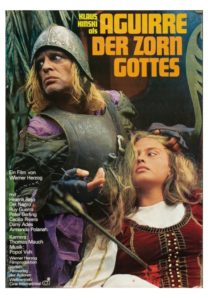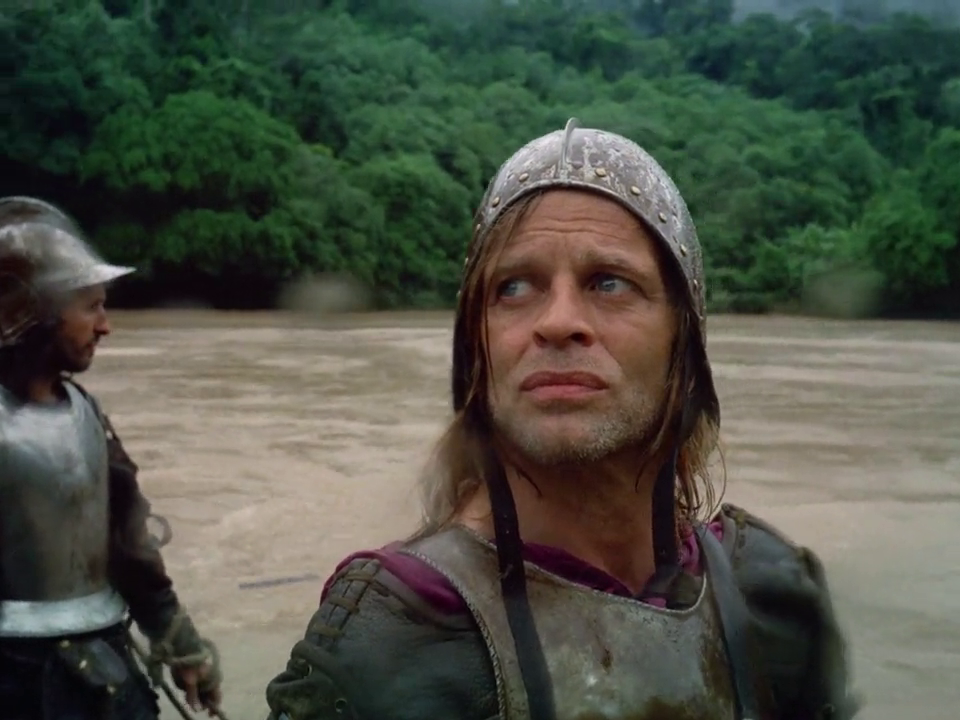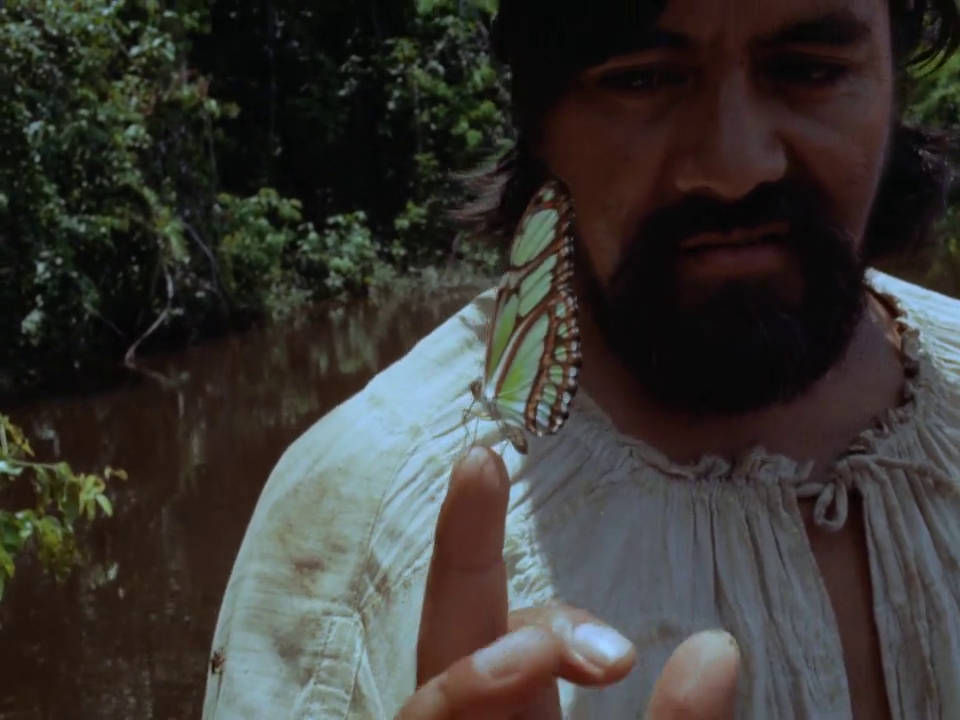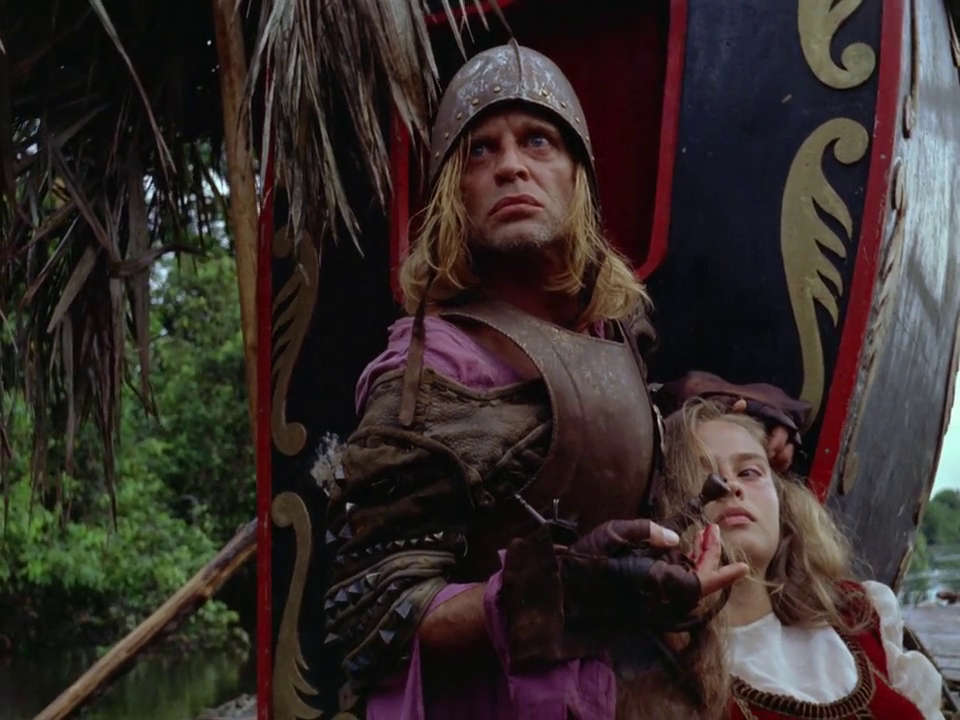|

Synopsis:
When a mad Spanish conquistador (Klaus Kinski) rebels against the leader (Ruy Guerra) of an expeditionary crew sent by Francisco Pizarro in search of fabled El Dorado on the Amazon River, the fortunes of Kinski’s entire crew — including Guerra’s wife (Helene Rojo), Kinski’s 15-year-old daughter (Cecilia Rivera), a nobleman (Peter Berling), an African slave (Edward Roland), and a monk (Del Negro) chronicling their travails — quickly unravel.
|
|
Genres, Themes, Actors, and Directors:
- At Sea
- Historical Drama
- Living Nightmare
- Ruthless Leaders
- South and Central America
- Werner Herzog Films
Response to Peary’s Review:
Peary writes that this “fictional masterpiece” by director Werner Herzog was the result of Herzog taking “his cast and crew to unexplored regions of South America — steep mountain ledges and an Amazon tributary”, thus representing “filmmaking under the most trying circumstances” but with “priceless” results, given that “Thomas Mauch’s camera has gone back in time to a lost world that is at once beautiful and terrifying.” Peary points out that this “spellbinding” film — which “at first… is dreamlike”, but ultimately becomes “hallucinatory” — begins “with an incredible image of perhaps a thousand soldiers in full armor, women in long dresses, and Indian slaves dragging cannons along a narrow, steep mountain path”, and ends “with a delirious image of lone-survivor Aguirre stranded on a monkey-covered raft”. He writes that “the journey downriver is full of haunting images: ghostly figures moving in the brush, ready to pick off intruders with arrows, spears, and poison darts; an abandoned cannibal village; a small raft caught in a roaring whirlpool; [and a] hooded black horse that stands abandoned in the prehistoric jungle.” He points out that, “as in [his] other films, Herzog delights in placing characters in hostile environments where, having nothing tangible to fight, they are unable to cope” and “eventually their minds become mush from the constant horror, depression, and fear of death.”
Peary points out that “Aguirre himself has little dialogue, and that is delivered without emotions, but seconds after we first see Kinski — sneering and snarling, gnarled like Richard III, standing at an angle as if to signify he’s at odds with the world, twisting his head before moving his body — we recognize that he is contemptuous of the world and tortured by inner demons.” Peary argues that “certainly Aguirre is meant to represent Hitler (though George Armstrong Custer also is appropriate)”, but “his consistently poor leadership and frustration are treated with such mock delight by Herzog that there’s evidence Aguirre is used as a comic villain, and the film itself is, though somberly presented, a comedy about a most embarrassingly unsuccessful expedition, carried out not by heroic figures, but by nefarious Spanish imperialists who deserved the sad end Herzog happily writes for them”. Peary concludes his GFTFF review by noting that “Popol Vuh’s music contributes greatly, making the journey come across as a funeral procession.”
Peary’s comprehensive review (elaborated upon in Cult Movies) nicely describes this incomparable film, “whose very production seems too remarkable to comprehend.” It’s well worth viewing, numerous times.
Redeeming Qualities and Moments:
- Klaus Kinski as Don Lope de Aguirre

- Thomas Mauch’s cinematography


- Many memorable, haunting images



- Popul Vuh’s soundtrack
Must See?
Yes, of course, as an influential and long-standing cult favorite by a master director.
Categories
(Listed in 1001 Movies You Must See Before You Die)
Links:
|







2 thoughts on “Aguirre, the Wrath of God (1972)”
Agreed – a once-must, for its place in cinema history. I wouldn’t agree that it’s “well worth viewing, numerous times”. ~mainly because I don’t think viewers could take it numerous times. This is, in fact, only the second time I’ve seen it; the first was in NYC at a revival house – when Herzog films were in vogue among real (New York) film buffs. I don’t think that the average film fanatic would undertake Herzog films, as a rule – they’re way too challenging and off-beat and they seem to require a certain element of the brain for appreciation. (Of course, the more adventurous ffs will jump at them.)
‘Aguirre…’, in particular, has the appearance of being a rather complex film when, in fact, it’s rather simple. Still… it’s often disturbing and requires a different kind of concentration – there’s nothing casual about a viewing of it.
It’s certainly a “hostile environment” film and, in its challenge, has a kinship with Herzog’s ‘Fitzcarraldo’, a film of his that I prefer.
If only I could have seen Aguirre on the big screen. My first viewing: a worn out grainy New Yorker Video print on a 13 inch tube TV/VHS combo in a university library viewing cubicle my freshman year in ‘95.
Cramped surroundings notwithstanding, I was riveted and have seen it multiple times through the years. I categorize this as a movie to be experienced but might not be enjoyed, depending on the viewer. I had a similar experience with my first viewing of Night of the Living Dead as a kid: scared but both repelled by and attracted to it at the same time. That said, I highly recommend seeing it at least once. I recognize that most people let alone film fanatics won’t see it as Herzog is an acquired taste and his work has always eluded mainstream audiences, but some things are worth trying once regardless and I think this is one of those.
To David’s point, it is a deceptively simple story. Simple and yet not easy: not easy to watch and certainly grueling to make. But the visuals are rich and rewarding, yielding new things every time you watch it. The jungle towers over and envelops all: there’s nothing sentimental about it in the survival tale of Aguirre. Herzog captures a claustrophobic, rugged space on camera in the first half and then in the second half places his surviving characters effectively as sitting ducks on a raft anticipating attack at all times from a hundred yards away: total doom.
I agree that Fitzcarraldo too is a great film that I also think everyone should see. It too was fraught with logistical problems, more of them for sure over several years, but Herzog’s choice to linger on the atmospheric visuals longer and to expand it to an epic length diminishes its power somewhat by comparison. Fitzcarraldo is more fascinating to me now that I am familiar with the behind the scenes details provided in Burden of Dreams. On its own it is interesting but very slow and too long.
Backstory was not necessary for me with Aguirre: it had me from the outset and locked me in throughout. I credit a documentary and improvisational shooting style, and solid editing and pacing as having a lot to do with it.
It is the quintessential movie by a director constantly challenging himself, his cast and crew, the elements, and his audience. It is his first masterpiece. If you only see one of his films, this is the one to see, followed close behind by Fitzcarraldo.
Related note: Shout! Factory’s Blu-ray version contains Herzog’s engrossing and engaging director’s commentary—well worth the investment if you’re a fan of his work.